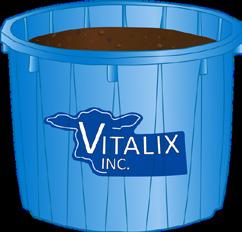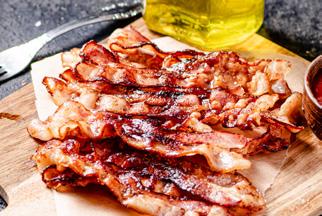FARMily Adventures Await in Utah
Preserving Living History on the Monastery Farm
Hope and Healing: Mental Health Support for Agricultural Communities




FARMily Adventures Await in Utah
Preserving Living History on the Monastery Farm
Hope and Healing: Mental Health Support for Agricultural Communities




BY VALJAY RIGBY, PRESI DENT, UTAH FARM BUREAU FEDER ATION

ILOVE this time of year.
Summer is a time when harvest begins for some of our crops, just as gardens from many of you will be ready for harvesting tomatoes, corn or zucchini.
There is also a lot of excitement in the air, from major holidays and community festivals to the coming County Fairs and State Fair in Salt Lake City in September.
It is a time when the wonders of agriculture can be on full display.
We truly have a lot to celebrate in agriculture and you’ll read some of those stories in this magazine.
You’ll read about opportunities to experience agriculture firsthand –whether that is through a farm camp or other agritourism opportunity or through buying delicious food at farmers markets. You can be inspired
about how one family is continuing the tradition of the historic monastery farm, and we hope to build empathy and understanding for those suffering from mental illness or stress, knowing that there are resources available.
Lastly, the summer is a great time to take advantage of the many benefits of belonging to the Utah Farm Bureau. Easy ways are our member benefits, such as discounts to places like Lagoon, hotels & car rentals, and more. But the value of your Farm Bureau membership doesn’t end there. It helps support farm and ranch families in our state through the work Utah Farm Bureau does as we work to keep agriculture alive and thriving in Utah – ensuring we have local food and thriving communities. Thank you for your membership in the Utah Farm Bureau and enjoy the best time of year!

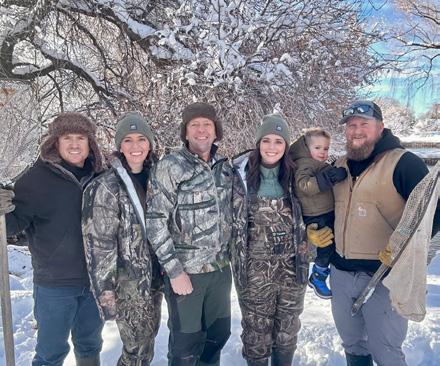


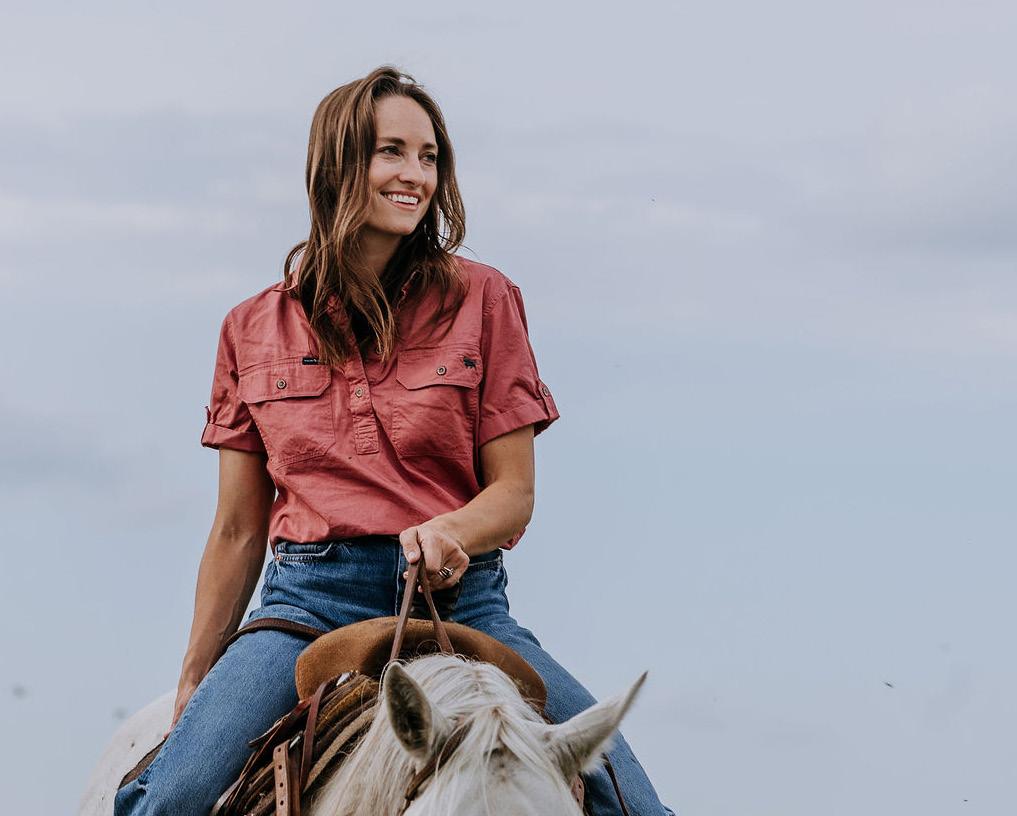

BY MATT HARGREAVES, EDITOR, UTAH FARM & FORK MAGAZINE
The story of Natalie Kovarik’s influence in agriculture is effective because of apparent contradictions. The Nebraska rancher has a growing legion of followers – or discos as devotees to the ‘Discover Ag’ podcast are known – in which she and her co-host Tara Vander Dussen try to build connections to the very tangible world of agriculture through virtual experiences. Kovarik and her husband Luke are getting to forge their own traditions and best practices as the first-generation owners of their own cattle ranch – Kovarik Cattle Company – and yet she has decades of experience growing up in a ranching family in southwest Montana. However, one thing that has no contradiction is Natalie’s dedication to helping build trust in agriculture – whether that is for new young farmers in rural
communities or a young mother living in suburbia or the big city.
Natalie grew up with three older sisters working on her family’s cattle ranch near Bozeman, Montana. Though loving that lifestyle, she said her parents gave their children the “gift of a choice” when it came to staying on the ranch.
“My parents wanted to make sure that if we decided to come back to the ranch, it was because we were choosing to. Not because we felt compelled or forced to,” Kovarik said. “So, they encouraged us all to get training or education off the farm to help us make that choice.”
After doing undergraduate work at Washington State University, Natalie decided to go to pharmacy school at the University of Montana and became a pharmacist. She enjoyed her time working in medicine until a fateful

day came as she was helping at her family’s ranch. Cattle ranching can be quite diversified in what a family wants to focus on. While most ranches raise cattle that eventually enter the food system, others specialize in genetics and raising quality breeding animals for other cattle ranches to buy and incorporate into their own ranch.
This was the case for Natalie’s family, and they were hosting a bull sale on their ranch when she met Luke Kovarik, a rancher from Nebraska who had come to purchase a bull.
After dating long distance, the two got married and Natalie moved to the Sandhills region in northcentral Nebraska where Luke was from. She was still working as a pharmacist, while also working alongside her husband in various agricultural pursuits when the couple made a few choices that would change their lives forever.
With the first choice, the couple decided to follow their heart. They dropped their off-farm jobs and focused exclusively on growing the ranch Luke started when he came home from college as their main income source. Though both were raised in agriculture, building this 1st generation ranch gave them to chance of growing their business from the ground up the way they saw best.
“I knew the industry and my background helped me know some of what to expect in this new role, but it is a lot different when you’re the one having to make the ultimate decisions compared with simply growing up on the ranch,” Natalie said. “But it is very rewarding to build this ranch with my husband into something of a legacy. We’re not captive to tradition to have to do things the way they always have been done and are able to make the decisions with just the two of us.”
Natalie acknowledges there are benefits to continuing a
multi-generation ranch, and stresses of trying to start one on your own. There is no perfect template of how to get their ranch going, and the next major decision Natalie made definitely didn’t come from the beginner’s guide to ranching.
Like most industries, technology has transformed the way many in agriculture do business, such as automating certain jobs or enabling more informed decision-making. It can speed up production cycles and shorten the distance between a business and its customers. It has also shortened the distance between consumers and the many details surrounding how their food gets to their plate. This is where Natalie saw an opportunity, if not right away.
“After running and launching this direct-to-consumer beef business with my friend for two years, I realized it wasn’t a perfect fit for our family ranch, but I saw the potential to influence people beyond just selling beef,” Natalie said.

After stepping away from that beef business, Natalie was at a conference learning about online marketing and heard from employees of YouTube about the interest in agriculture they were seeing on the backend of the platform. All of the information was telling them about the potential to influence others. She decided to bet on herself.
“I told my husband that I wanted to tell our story more and influence others about agriculture,” she said. “But the interest was in the people behind, not the beef itself. In my gut, I knew there was something here. So, I made the decision to build a brand around myself.”
More than just a passion project, Natalie knew she could be successful and could make a business out of influencing. She dedicated herself to this new project 100 percent and has steadily grown opportunities
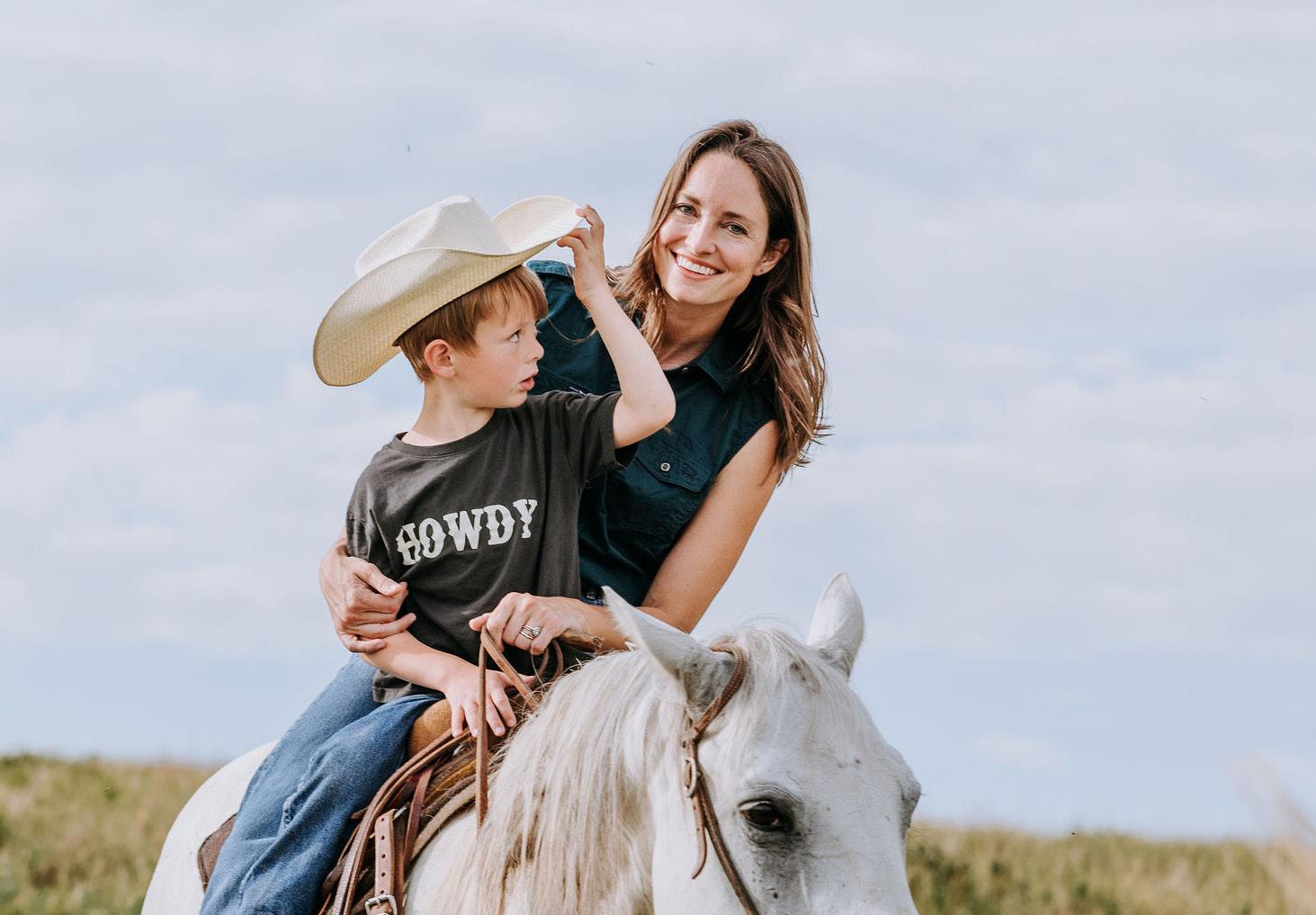
for her family by sharing her love of agriculture, of food, and the lifestyle of agriculture. While initially focusing on YouTube, Natalie has found her niche by focusing on Instagram and the popular podcast ‘Discover Ag’.
“It takes a lot of work. A common misconception is that it’s easy to be successful doing this,” Natalie said. “Many are surprised to learn the money and time you need to invest into being successful. It’s hard to have your phone out a lot and my husband had to get used to it, but once I could show how the things I was talking about and sharing helped the bottom line, he was even more supportive.”
One of the things Natalie enjoys most about her time spent online engaging with others is the ability to share multiple sides of current issues surrounding food and agriculture in ways that can connect to younger generations.
“There is a great interest, maybe more than ever before or more than in a long time, to connect to our food and where it comes from. But people are doing it in a different way now than before,” Natalie
and building relationships, nor does it limit the choices consumers have on how they want to consume food.
said. “People used to read longform stories of complex issues, getting multiple perspectives that were vetted and thought out, and now, most of us are really busy and our knowledge is driven more by soundbites and headlines. And unfortunately, because many are disconnected from their food sources, there are a lot of misconceptions about it that are spread. Those are hard to correct or unlearn.”
But Kovarik doesn’t put the responsibility of deciphering fact from fiction on consumers, rather, she takes it head-on as her opportunity to share her experience and connect with others so they can trust her.
“I don’t think consumer education is as important as consumer trust,” Natalie said. “Some things we understand simply because we’ve been living in this industry and lifestyle, but we can’t expect others to be that way. We just need to focus on helping consumers trust that farmers and ranchers know how to make the best decisions for producing food.”
With that emphasis on trust, Natalie is quick to point out that this doesn’t limit efforts by farmers and ranchers need to make to keep reaching out
“There is so much nuance in our conversations about food. People often want to make choices based on a simple ‘this’ or ‘that’ variable based on science, but nature just doesn’t work that way,” Natalie elaborated. “I’m often asked by people to help guide them on the kinds of foods they should buy, but I ask them to tell me what’s important to them, and then I can help guide them. If the environment is ultimately important, then that can lead to certain food choices. If price is the most important, then that can be another set of choices, etc.
“Our food system is a spectrum of choices, not something that is cut & dry,” Kovarik continued. “These food choices will involve all kinds of trade-offs, but people don’t like to think of that with their food.”
With time spent refining her brand, Natalie has been able to grow her influence in ways unimagined, from speaking opportunities and working with brands, to presenting at the South by Southwest (SXSW) conference in Austin. Presenting with her podcast co-host at this major culture festival was an opportunity to connect consumers to someone who has a direct influence on their food. Kovarik hopes connecting farmers and consumers – either faceto-face or through a social media or podcast feed will help humanize our food system and lead to increased trust so that all will thrive.
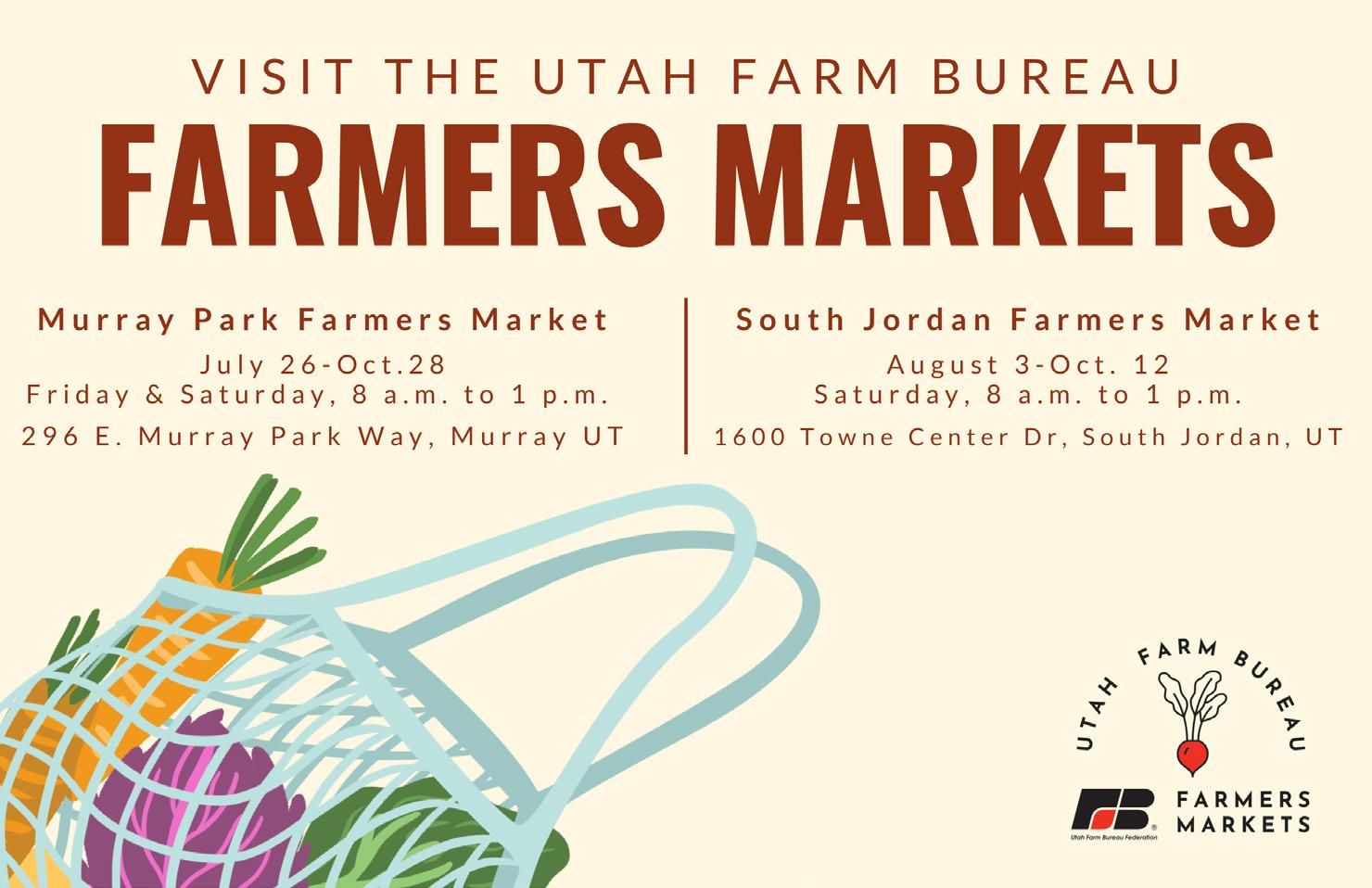


Connect with Natalie online at nataliekovarik.com, @nataliekovarik on Instagram, or Discover Ag on your favorite podcast platform. Day of Wreckoning Demolition Derby
September 6, 7 & 9
September 14

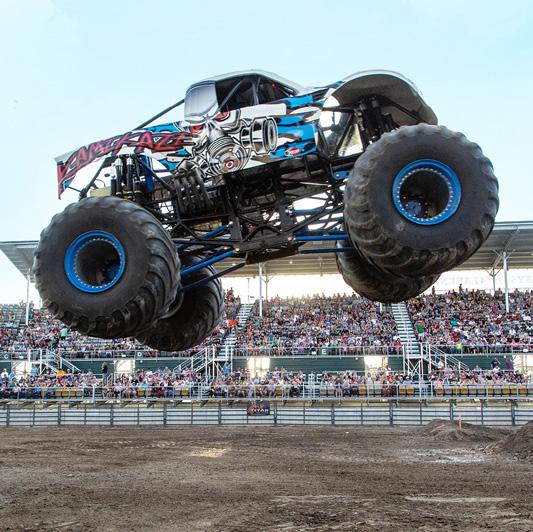
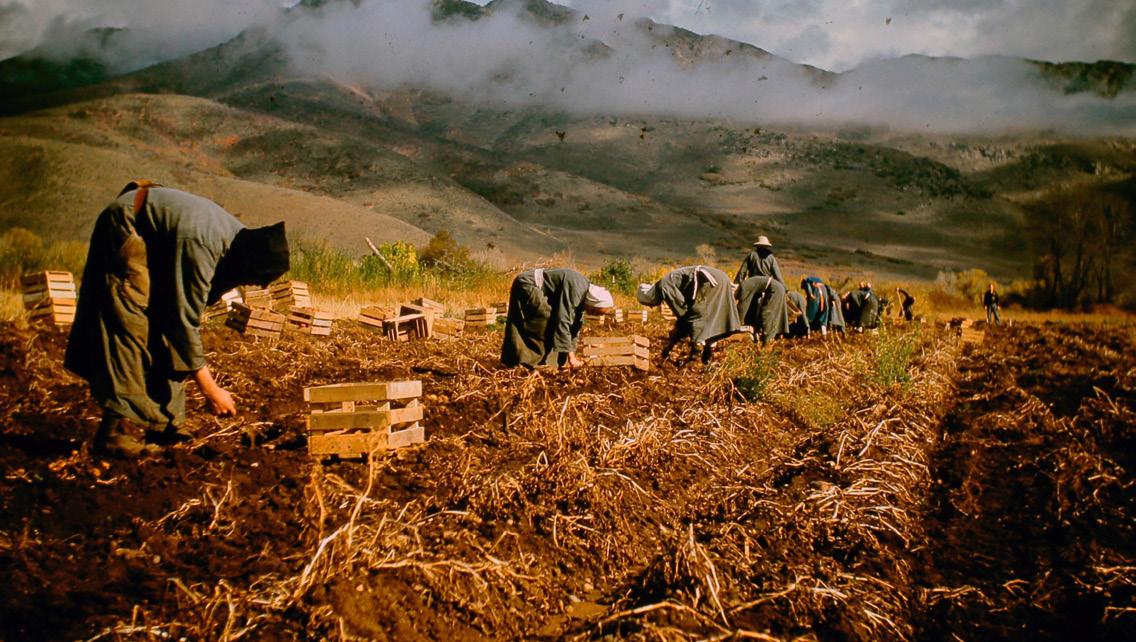

BY JULIA MISIEGO, FOOD WRITER, UTAH FARM BUREAU
When Kenny and Jamila McFarland first toured the Historic Monastery Farm in Huntsville, Utah it was supposed to be for consulting purposes. The current owners had reached out to them for advice on what to do with the agricultural fields.
“The owner had found us on the internet,” Jamila McFarland said.
“He loved the simplicity of our farm and business and he wanted to consult with us about his farm.”
However, once they were onsite, they fell in love with the farm in Weber County.
“The farm has such a special and unique spirit,” Jamila said.
“The monastery was a place of refuge for the monks and the surrounding community alike. We wanted to be a part of preserving and continuing that heritage.”
The McFarlands were already so busy with their own family farm, but they were intrigued by the challenge and the opportunity, so in
2022 they started leasing the fields and became part of the history of the Historic Monastery Farm.
In 1947, 32 Trappist monks (many of them returned World War 2 veterans) from the Abbey of Our Lady of Gethsemane in Kentucky traveled to Utah to build the Abbey of Our Lady of the Holy Trinity (referred to locally as the Huntsville Monastery or simply “The Monastery”). They were Trappist Cistercian monks, which, according to Wikipedia, is an enclosed religious order known as the Order of the Cistercians of the Strict Observance. Some markers of the Order are hard work, strict piety, and a structured schedule.
They lived in old World War 2 barracks for a little while, before moving into Quonset huts, giving the monastery a distinctive image.
“The outside was a little nontraditional, but the inside chapel was traditional and constructed beautifully, and it was easy to forget you were inside a Quonset hut,” Jamila said.

Land Conservancy, Ogden Valley Land Trust, NRCS, and area donors. A conservation easement ensures that the land will remain in agriculture and can never be developed, which was the desire of the monks.
The monastery itself is no longer standing, but the legacy of agriculture and community connection lives on.
The monks came from all walks of life, and the monastery became a refuge for World War 2 veterans and the local community. The monks grew hay, grain, potatoes, and other crops to eat and sell. They had a public-facing store where they would sell their own farmraised products such as eggs, bread, and honey, along with religious goods.
“Almost everyone in the Ogden Valley has memories of buying bread and honey from the Monastery,” Jamila said. “So many people have a connection, whether that was befriending and learning from the example of the monks, attending mass, or shopping at the store.”
The monks lived, worked, worshipped, and died on the farm until 2017 when the mother monastery in Kentucky determined the surviving monks were not receiving adequate care. So, in August, after one final mass, the monastery was closed.
According to the Natural Resources Conservation District, the farm was sold and subsequently put into a conservation easement, thanks to the work of the landowners Bill White and Winston Wangsgard, the Summit
Kenny and Jamila McFarland currently grow crops on 700 acres of the historic farm, including organic hay, wheat, onions, and U-pick pumpkin fields that are open to the
public in the fall. They recently also organized a Farmer’s Market on the property during the summer.
“We were motivated to offer a Farmer’s Market because people kept asking us where they could buy local vegetables,” Jamila said. “We have our own vegetable stands around Weber County, but I wanted to have a full Farmers Market on the property to offer the community fresh local food and continue the connection and legacy of the historic farm.”
The Farmer’s Market is held each Saturday with more than 20 local vendors. They also have music,
local bands, and yard games. The market is held against the backdrop of the pumpkin crop, so customers can watch the farming process as the summer progresses.
The McFarlands plan to continue offering the market and additional events in the future. They believe there is a reason they should be farming the land, and they feel encouraged by the community and grateful for the opportunity.
“No one has ever told a farmer you can farm forever,” Jamila said. “Development is always on the horizon and you’re always trying to run from it. But this land is preserved forever. It’s a huge blessing for us to be a part of that preservation and for the public to feel the spirit of the monastery and enjoy the events we offer there.”
For more information, visit www.mcfarlandfamilyfarms.com.



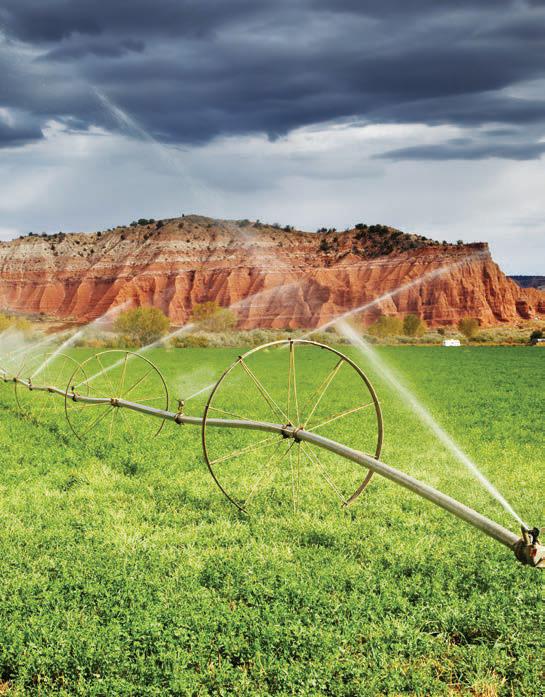


BY ADELAIDE CORY-DISCH, FARMERS MARKET MANAGER, UTAH FARM BUREAU
It’s summertime and the raspberry flats will be calling my name very soon. As the farmers market manager for the Utah Farm Bureau, I’ll soon be surrounded by more Utah produce than I could possibly eat, and that means the prospect of stocking up my pantry with glowing jars full of homemade jams and sauces.
And it also means some really messy kitchen moments. But mess aside, I love knowing the product of a few hours of work will feed my family throughout the year. But lately, I’ve been hearing from market farmers that they see fewer and fewer people buying fruit and vegetables in bulk to bottle these days. It seems that for most Utahns, canning is a quaint pastime from their parent’s or grandparent’s generation. Is there still a place for home food preservation in the modern kitchen?
If you’re Anna Cash the answer is a resounding “yes”. A master food preserver in Ogden, Anna also runs an Instagram account called @ smarthomecanning where she shares advice for home food preservation. I loved seeing her share stories of her process, and last season I met her in person when she demonstrated her hand crank apple cider press at the Murray Park Farmers Market. As Anna tells it, she really wasn’t interested in canning until she purchased a home in Ogden with an apricot tree. She found she had too many apricots and didn’t want to waste them, so she turned to a food dehydrator and made fruit leather for her family. It was a hit, and she hasn’t stopped since.
For Anna, using the apricots from her yard to make fruit leather was just common sense- a money saver and a great way to avoid food waste. And if saving money is your goal, there are some great ways to make canning
a money-saver. One way is through purchasing “seconds” or bruised fruit directly from a farmer to make into jam. Another is by gleaning produce from smaller farms or U-picks that make their fields available at the end of the growing season. But even without taking advantage of these cheap or free options, canning at home has many other benefits. Supporting local growers in your area keeps money in local businesses – it’s estimated that $68 out of every $100 spent locally remains in the local economy. There’s also a nutritional benefit – eating locally is correlated with improved nutrition, increased likelihood of making healthier food choices, obesity prevention, and reduced risk of dietrelated chronic disease (Martinez et al., 2010). And, if you follow some of the advice from Anna Cash, it’s fun!
If you aren’t a home canner yet and you’re ready to join the bandwagon,
follow this sound advice from Anna and think small. “People want to do massive batches, but the way to go is smaller so it doesn’t become overwhelming.” Cash advocates for starting simple, and picking one thing you typically eat a lot of for your first attempt. One easy idea is to start with freezing berries or cut fruit. This way you can preserve really ripe Utah fruit without investing in any special equipment.
If you’re interested in making shelfstable food, water bath canners can be found cheaply online, and most grocery stores have ball jars and lids, as well as pectin and other basic canning supplies. Cash recommends starting with raspberry jam for your very first canning recipe, and suggests finding your canning recipe from the National Center for Food Preservation,
the USU extension office, or the Ball Blue Book Guide to Preserving. USU also hosts Master Food Preserver Workshops for those interested in delving deeper into the science (and safety!) of home canning.
Have you canned before and ready to go all in this season? This may be your year to try dill pickles! According to Anna, “If you can get a really crisp dill pickle [through canning], you’re winning at life.”
Here are Anna Cash’s top tips for getting crisp dill pickles:
1. Purchase your cucumbers the day they are picked.
2. As soon as you get them home get them into a bucket of ice water
3. Process them the same day you purchased them
4. Don’t skip the calcium chloride!
We hope to see you out at the farmers markets this year, buying some fresh produce for home canning! Try these tips. We’d love to see your own home canning adventures with Utah produce! Make sure to tag us @utahfarmbureau and @smarthomecanning with the results!
The Utah Farm Bureau Federation manages two farmers markets in Utah – in South Jordan by City Hall (www.facebook.com/ Utahfarmbureaumarkets) and at Murray Park in Murray (www.facebook.com/ murrayfarmersmarket) – but there are also a number of other farmers markets in the state, which can be found at www. utahfarmersmarketnetwork.org/ find-a-farmers-market.

























































Calling all shutterbugs!
After a year’s absence, it’s time once again for the annual Utah Farm Bureau photography contest, when you or someone you know can share your best pictures with the entire Beehive state, and possibly win a cash prize.
So charge your camera & phones and get your artistic eye ready for a great season of photography! As always, rural settings and rural lifestyles are welcomed themes for all submissions, but we welcome photos that showcase growing & enjoying food, and the connections we have all with food.
As in years past, we’ll have three categories. Utah Farm Bureau’s panel of judges will select the winners of two categories, “Kids in the Country” and “The Miracle of Agriculture”. “Kids in the Country” is for photos involving youth, children, or families. “The Miracle of Agriculture” is a broad category that will include photos showcasing the work of producing and
growing food and fiber in Utah, as well as eating and celebrating life through food. In short, show us how you’re connected to food!
The third category is simply called “BeUTAHful.” This is a “People’s Choice” may vote for the best image of Utah that showcases agriculture, rural life, and beautiful landscapes. The winner of this category will be decided by a fan vote on social media of five finalists. The finalists will be chosen by the Utah Farm Bureau’s panel of judges.
The finalists will be announced on social media in October, and fan voting will take place beginning November 1, 2024. More details on voting will be announced in the Fall Utah Farm & Fork magazine. Winners will be announced in the December 2024 Utah Farm & Fork magazine, with each category winner receiving $100.
DETAILS & INSTRUCTIONS
Are you ready to submit your photos? This year’s deadline is October 1,

2024, and is limited to Utah Farm Bureau members and their immediate families. Photography contest rules:
1. Digital entries are preferred and should be emailed to aubree.thomas@fbfs.com. For publication purposes, photos must be at least 1024 x 768 pixels or higher.
2. Print entries may be mailed to: Utah Farm Bureau
Attn: Aubree Thomas 9865 S. State Street Sandy, Utah 84070
A stamped, self-addressed envelope needs to accompany your print photo entry if you want your photograph returned.
Include a brief description regarding the entry, plus the participants' name, address, telephone number, and valid Utah Farm Bureau membership number.
Those submitting photographs agree to hold harmless and release Utah Farm Bureau Federation (UFBF) staff, officers, and affiliated entities from loss, claim, injury, damage, or expense. UFBF may, without offering any consideration to or obtaining permission of its submitter, use any such photograph for any purpose, such as publishing it in Utah Farm & Fork magazine, use on UFBF’s website or social media, or reproducing it for other UFBF use.
MIRACLE OF AGRICULTURE CATEGORY
BY JENNIFER JACOBSEN OF BOX ELDER COUNTY


INSTEAD OF BIKES IN JUAB COUNTY

JULENE REESE, PUBLIC RELATIONS SPECIALIST, UTAH STATE UNIVERSITY EXTENSION
Utah’s farmers, producers, and agricultural workers grapple with challenges often beyond their control — unpredictable weather, financial strains due to fluctuating commodity prices, labor shortages, relationship complexities, and the delicate balance between work and family life, which are often intertwined. Compounding these difficulties is the general reluctance to talk about mental health challenges, further jeopardizing their overall well-being.
Statistics from the National Rural Health Association show that agricultural workers are at a higher risk for mental health stressors, causing a suicide rate 3.5 times higher than the general population.
Josh Dallin, a Utah State University Extension associate professor and rancher himself, said USU Extension is acutely aware of the challenges faced by those in the agricultural community.
In 2020, the Agricultural Wellness Program (AgWellness) was established
to provide education, support, and mental health resources for farmers, ranchers, and their families.
In partnership with the Utah Department of Agriculture and Food, the AgWellness program offered the Mental Health Assistance program in 2023, which connected farmers who need mental health support to local therapists. However, the vouchers were so popular that funding was depleted. Dallin says the program is seeking other funding sources, including state funding, private donations, and other grant options.
“The biggest takeaway here is that those who have sought help have seen a big difference in their lives,” Dallin says. “We are optimistic that we will be able to find the funding to continue helping those in need. In the meantime, the Extension AgWellness website (extension. usu.edu/agwellness) includes information on other helpful programs we have available, including a podcast and two online courses.”
Sadie Wilde, USU Extension assistant professor and a member of the AgWellness team, often fields calls for the program. She says it has been incredible but also heartbreaking to hear the stories of those who finally mustered the courage to reach out.
“I think everyone on our team has shed tears over the touching stories and thank you letters from individuals and families we have had the privilege of supporting this year,” she says. “We have also had some close-call situations, including someone who had a suicide plan for the very evening they called in. We know this program has saved lives this year, and I am so grateful to be part of such a meaningful effort.”
As part of their education, AgWellness team members participated in a mental health first aid training course that provided suicide prevention education.
When Dallin participated, he felt like the information was helpful, and he hoped it would be useful to those in attendance. But in the back of his mind, he didn’t think he would personally ever use it. He felt like things were going well in his life and in the lives of those close to him. But two weeks later, everything changed.
“I was visiting my parents, and my little brother, who is very successful and has a lot of great things going
for him, sat across the room from me,” Dallin says. “To my shock, he told me he had contemplated suicide and didn’t want to live anymore. I had absolutely no idea. It turns out he had been suffering for years, and he knew something was wrong, but he didn’t want to admit it.
“Little did I know that all the things I learned from that training were going to come into play, and they were coming quickly. Questions I needed to ask him, how I should respond — they were readily available to me because of that training. This started a movement for me personally, just because it hit so close to home. I thought, ‘If my brother is one of those people I had no idea about, then how many other people’s brothers and sisters and moms and dads are also struggling?’”
“THE MORE WE TALK ABOUT IT, THE MORE NORMAL IT WILL BECOME TO SEEK HELP.”
Dallin says they learned his brother had a traumatic brain injury earlier in his life, and something physical was causing his issues. He finally got the proper treatment and is doing well. In fact, he has become an ambassador, trying to help break the stigma and encouraging people to reach out for help if they feel something is wrong.
“If you had a tractor run over your foot and break it, you’d definitely go to the doctor,” says Dallin. “You’d wear a boot, you’d wear a cast, you’d do whatever you had to to fix it. But for whatever reason, a lot of people don’t think the same way when it comes to their mental health. They feel ashamed or embarrassed and don’t consider getting help for these issues as they would for physical
health issues. But we have to realize that the more we talk about it, the more normal it will become to seek help. Our AgWellness program has multiple resources to encourage people to open up and share.”
The AgWellness Podcast (www. extension.usu.edu/agwellness/ podcast/) explores mental health in farming and ranching communities. Podcast moderators Dallin and Jacob Hadfield, also a USU Extension assistant professor, share stories about the impact of mental health challenges and provide information about where to obtain resources. The AgWellness podcast website includes 14 episodes.
In addition, there are two free online courses. Through self-guided learning modules, the AgWellness Course helps participants learn skills to manage stress and improve wellbeing. The Mental Health Awareness and Advocacy for Ag Course helps participants identify mental health concerns, locate community resources, develop skills to identify someone experiencing a mental health challenge and refer that person to the appropriate resources. Dallin and Hadfield have also taught “The Biggest Asset is YOU,” a class they’ve delivered 20 times to groups around the state.
“We are excited to be part of this program and see the positive changes it can make for those in agriculture who need mental health assistance,” said Hadfield. “Though many in the ag community perceive it as a weakness to admit they are struggling, it really is just the opposite. Having the ability to admit we need help is truly a strength.”
For further information about the program and resources, visit the Extension AgWellness website. In addition, those wishing to donate to the program can visit the USU giving website — www.givecampus.com/ campaigns/41971/donations/new.

BY SUSAN FURNER, VP—CONSUMER ENGAGEMENT, UTAH FARM BUREAU
Are you looking for new adventures to experience with your family? Have you ever considered a “FARMily” adventure? You may be surprised by how many opportunities there are in Utah to participate in agritourism.
Agritourism is where agriculture and tourism meet. This tourism is broadly defined as farmers and ranchers inviting visitors to a working farm, ranch, or other agricultural business to participate in educational (often hands-on) activities to provide guests with a taste of farm and ranch life.
Agritourism comes in several different forms—1) educational experiences such as farm camps, pumpkin patches, and corn mazes 2) direct agricultural sales such as U-pick operations, roadside farm stands, and farmers markets or 3) farm and ranch accommodations such as dude ranches, cattle drives, or wedding venues. Each provides unique opportunities to personally experience agriculture.
Agritourism is catching on in Utah and attracts both local and outof-state visitors across the state. Harmony Cox, a fifth-generation cattle rancher in Kane County, suggests why there is such a heightened interest in visiting farms.

“It wasn’t very many years ago when you would meet someone and tell them you were a rancher and they would reply with something like, ‘My dad was a farmer.’ Or ‘I spent summers on the farm.’ But today that exchange is becoming more and more rare,” Cox said. “More and more people have no personal connection to their agricultural heritage, but I believe that God instills within the human heart a need for connection to heritage and His earthly creations. That’s why I think people are so hungry for an agricultural exchange right now.”
No one can argue the fact that farming is a difficult, risky business. Farmers face uncertainties in
weather, crop yields, input costs, and market prices, so agritourism can add a stabilizing income that allows farms and ranches to remain economically viable. It can also provide a way to include future generations to stay on the farm.
For Staheli Family Farms in southern Utah, agritourism has helped the family farm remain open and preserve agricultural land and open space amid the rush of new housing developments.
The public benefits because agritourism provides individuals with the opportunity to learn about rural living, nature, and the agricultural industry, and it also connects them
about 20 years ago when Burke Staheli, who worked in elementary education, noticed there was a disconnect with kids knowing where their food came from. The family felt that if the children could experience the farm firsthand, they would begin to understand and make connections.
Every year Sherrie (Staheli) Tate runs summer farm camps where kids learn what it’s like to be a farmer. The children do morning chores, interact with farm animals, learn, and play on the farm, but campers work first, and play last. They learn responsibility and make new friends all while having fun.
Agritourism at the Staheli Family Farm has expanded over the years to include corporate training experiences, and seasonal festivities year-round such as Easter events to Christmas on the Farm. Fall is one of Staheli’s busiest times with fall events including a Pumpkin Patch, Field of Screams, and a Corn “Maize” that attracts an average of 30,000 visitors during the month of October. The farm is also available for family reunions, weddings, and has a farm store where you can purchase local beef, and fresh produce in season.
with local food and an understanding of local food systems. Visitors can see firsthand how farmers and ranchers care for and protect land, animals, and natural resources.
The Staheli Family Farm is a six-generation farm located in Washington, Utah. Today the 350acre farm is different than it was when Frank Staheli, Sr. established it in 1889. The Staheli family continues to plant seeds and care for crops and animals, but they’ve also cultivated new ways to share the farm with visitors.
Staheli’s opened their farm to visitors
Sherrie says the best part of bringing people to their farm is hearing people reminisce about their agricultural ties. People tend to relax more on the farm—they feel different. She hopes she plants the seed of how important agriculture is in their lives and that they make the connection from farm to table and that visitors sense the “family” feeling and feel a part of it.
Learn more at www.stahelifamilyfarm.com.
Cold Springs Trout Farm is located at the base of Cold Water Canyon, only minutes from downtown Ogden.

The farm’s water source comes from Rocky Mountain springs. This cold-water natural resource is key to raising great tasting Rainbow, Brown, Brook, and Tiger Trout.
This family farm has been operated by the Barker family for the past 100 years.
Neal and Carrie Barker have seven daughters, including triplets. Two of the triplets, Tarah and Tylynn wanted to come back to the farm so Tarah got her degree in business from Weber State University and Tylynn received her degree from Utah State University in fisheries and aquatic sciences. The sisters, along with their husbands, are now running the farm.
Tarah says she received a lot of experience growing up on the trout farm, but she was thrilled to find journals of her grandfathers who recorded how they experimented and came up with best practices for raising fish, and how they handled the challenges that came their way.


In addition to selling eggs and live fish, Cold Springs added agritourism to their farm. With seven daughters, it just made sense to offer a wedding venue. So, in 2005 the Bowery was built and as each daughter was married something new was added to the wedding venue, a gazebo, a dance floor, and more green space. Trees were cleared to reveal a majestic mountain backdrop, and each year more flowers are added to the grounds creating a beautiful and peaceful setting.
In the summer, the farm is open to weddings, family reunions, birthday parties, corporate events, baby showers, rehearsal dinners, picnics, and more.
Children can discover the excitement of catching their first fish from one of the Catch n’ Keep ponds – no fishing license necessary. There’s also a Fly-Fishing Catch and Release

The Cox family loves to share their cowboy way of life.
“We strongly believe that when God blesses you with something rare and beautiful, He wants it to be shared,” Cox said.
Pond that offers a variety of trophysized trout and white sturgeon.
Visitors can enjoy fall festivities on the farm at the Jailhouse Maze which is changed from week to week to keep it fun and challenging.
Cold Springs Trout Farm is open from April through October. Learn more at coldspringstroutfarm.com.
Harmony Cox’s second greatgrandfather, Jonathan Heaton, was an original settler of the Alton, Utah area. He loved, lived, and worked the land with his family. Dustin & Harmony Cox along with their six cowgirls continue his legacy at The Ranch at Wild Rose nestled on 180 acres of beautiful Utah landscapes, centered between Zion National Park and Bryce Canyon.
The Cox family offers a variety of cowboy experiences including cattle drives, branding team building, and weddings. Opportunities range from day trips to 10-day trips and everything in between. You can join them for a day of calving or branding.
Guests participating in the spring and fall cattle drives help push 850 head of cattle 110 miles to their summer grazing to the north rim of the Grand Canyon. It’s a fiveday cattle drive. Guests camp and eat along the trail with the cattle and gather around the campfire at night to share stories of the day.
The family is excited to welcome friends to experience a piece of their heaven.
“I love watching guests experience for the first time the miracles we see every day. It’s easy to forget how special our life is. We see the miracle of life, of renewed wealth every day.
How special that is!” Harmony said, “Watching our guests’ eyes light up as they experience it for perhaps the first time is beautiful and gives me renewed appreciation for all that God has blessed us with.”
Learn more at www.theranchatwildrose.com.
DISCOVER MORE AGRITOURISM OPPORTUNITIES
These are just a few of the many available agritourism opportunities in our state. The Utah Department of Agriculture and Food (UDAF) maintains a voluntary agritourism registry to provide public notice of locations where individuals may participate in an agritourism activity. Farm owners may voluntarily place their agritourism venue and activities on the registry by providing information to the Department. The registry is posted on the UDAF website.
Additional Agritourism Operations in Utah
• McFarland’s U-Pick Pumpkin Patch (Huntsville Monastery) (see page XX)
• Once Upon a Christmas Tree Farm/Petals & Pine
(Tremonton)—Seasonal events and activities
• Heber Valley Cheese (Midway)— Dairy tour, seasonal festivities, workshops and farm store
• Glen Ray’s Corn Maze (Spanish Fork)—Corn maze and seasonal festivities
• Green Acres Farm (West Weber)—Sunflower festival, corn maze, pumpkin patch
• Sunder Creek Farms (Chester)— Pumpkin Patch and corn maze
• Roberts Family Farm (Layton)— Farm stands, farmers markets
• Dibble Farms (Layton)— Fall festival, farm store
• Cross E Ranch (Salt Lake)—Fall festival, sunflower festival, special events, and more. (see page XX)
• Hee Haw Farm (Pleasant Grove)— Seasonal festivals, farm activities, petting zoo, and farm store
• Riley’s Orchard (Genola) U-Pick and Farm Stand
• Clark Family Dairy (Morgan)—Corn maze
• Harward Farms (Springville)— Farm camp, Jaker’s Pumpkin Patch, hayrides, farm stands
When planning your upcoming staycations or vacations, consider one of the many FARMily Adventures Utah has to offer.


BY MATT HARGREAVES, EDITOR, UTAH FARM & FORK MAGAZINE
With the redevelopment of the Salt Lake City and City Creek shopping area and the explosive growth in the Salt Lake Valley and suburbs in recent years, it may surprise readers to know of a holdover from Utah’s early settlers still ranching within the shadows of jumbo jets and fulfillment centers. But the Hinckley Cross E Ranch continues to be a stable influence in the community and shares its story of survival.
“We want to help make a connection to agriculture at our ranch for any that come to visit – even if just for a minute,” said Heather Limon, owner of Cross E Ranch in North Salt Lake. “We face continued
encroachment from development and are farming on ground that isn’t the best, but we don’t want to sell and move somewhere else.”
In 1867, Brigham Young, president of The Church of Jesus Christ of Latter-day Saints, commissioned Heather’s 2x Great-Grandfather Ira N. Hinckley, to build a fort in Millard County – halfway between Salt Lake City and St. George –which came to be known as Cove Fort. Ira became a well-known figure in Millard County and after the fort was no longer used, the family found themselves farming the fertile soil set near the Sevier River in nearby Bloomington, Utah. In 1891, the name Bloomington was dropped and replaced with the name Hinckley in honor of Ira. The Hinckley family lived and farmed in Hinckley for many years.

now 5th and 6th generation farmers in Utah, and we are thankful every day for our dad and grandpa.”
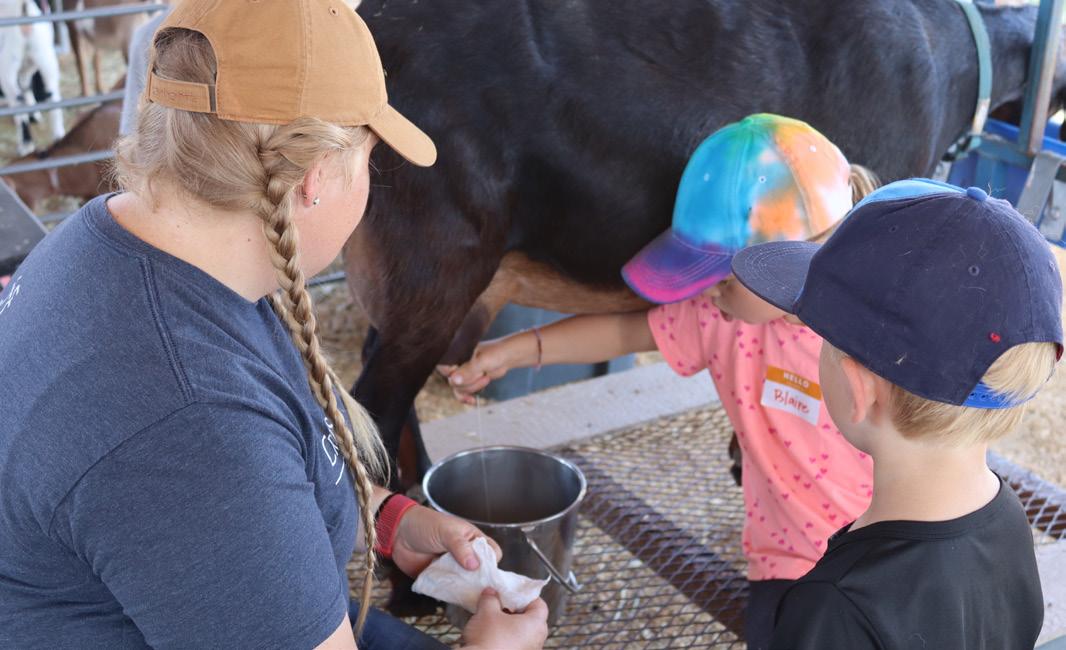
also made farming difficult – including the rise of fulfillment warehouses and other commercial projects.
Fast forward to 1934. Alonzo Arza Hinckley, son of Ira, was called as a member of the quorum of the 12 apostles in the Church and found himself moving from Millard County to Salt Lake City. His children, who were adults by then, followed him to the city. Two of his sons, Rulon and Arza, purchased and farmed all of the ground that is now the Salt Lake City airport. These brothers were among the first to raise and breed purebred black Angus cattle in Utah.
“Rulon’s son, and our father, David Hinckley, began farming as a young boy and loved farming,” Heather said. “He left the farm as a young man to chase his dreams, but the farm never left his heart. As soon as he got a chance, he returned and began his career as a rancher. He farmed this area for more than 40 years. We are
The Cross E ranch name (+E) comes from the brand the family uses on their cattle. The brand is one of the oldest brands west of the Mississippi, though it originally belonged to the Jeremy Family, who were sheep ranchers in Utah. David Hinckley began leasing the farm from Tom Jeremy in the 1960s where he leased both Jeremy’s land and his cows. Despite the hard growing conditions because of the alkaline soil, Dave worked relentlessly alongside Tom for years to build the ranch, and Dave became like a son to him. After many years working together, Dave had the opportunity to finally buy his own herd of cattle with financing help from Tom Jeremy, and so the Hinckley family paid tribute by continuing the use of the brand.
Heather (Hinckley) Limon continues the tradition of farming excellence learned from her father and she negotiates the changing times and encroachment of neighboring development. A growing community has certainly brought changes and challenges for the family, which has included losing grazing land where the Salt Lake International Airport now stands, as well as the new state prison. Other changes while smaller in scope, have
The changes have caused the family’s cattle herd to change dramatically, from raising over 1,000 head of cattle to now less than 50. It also makes farming land and harvesting crops more difficult, because of the challenge of moving equipment in populated areas and the ability to generate returns on that expensive equipment. To help stave off the challenge of development and keep agriculture alive in Salt Lake City, Limon and her brother (Dalon Hinckley) are working to secure a conservation easement, which compensates the family for the exchange of the land’s development potential and allows the Cross E Ranch to continue to stay a productive ranch.
But Limon will tell you that growth can bring opportunities as well. She and her brother have opened the farm up to guests from throughout the community who are almost amazed to see a cattle ranch within sight of downtown Salt Lake City. It is almost a little jarring to see airline jets taking off in the viewshed of the farm. Limon opens Cross E Ranch up to classroom and preschool visits as well as guests to any of the several festivals they host.
“We’ve brought in about 80,000 visitors during our fall festival and around 40,000 for our spring festival,” Limon said. “They come and eat hamburgers that we make from our own beef, line up for apple cider donuts, and go through our corn maze or pumpkin patch. We also have sunflowers and are working to have a tulip festival in the spring.”
The rise in agritourism has helped bring additional understanding of agriculture as well as commercial opportunities to help offset the bottom line, but it’s not without effort. Managing staff, negotiating hiring and training employees, and navigating the at-times confusing regulations all take time and can be confusing, but they can provide opportunities for future generations to continue the farm and find a place where they can contribute.
Opening up farms to the public has proven to be a great way to build connections to what was once commonplace to most of residents and solidify that relationship to our most basic need of growing food and growing community.
The Sunflower Festival at Cross E Ranch starts September 6 and the fall festival shortly after on September 20. For more details and information, visit https://www.crosseranch.com.



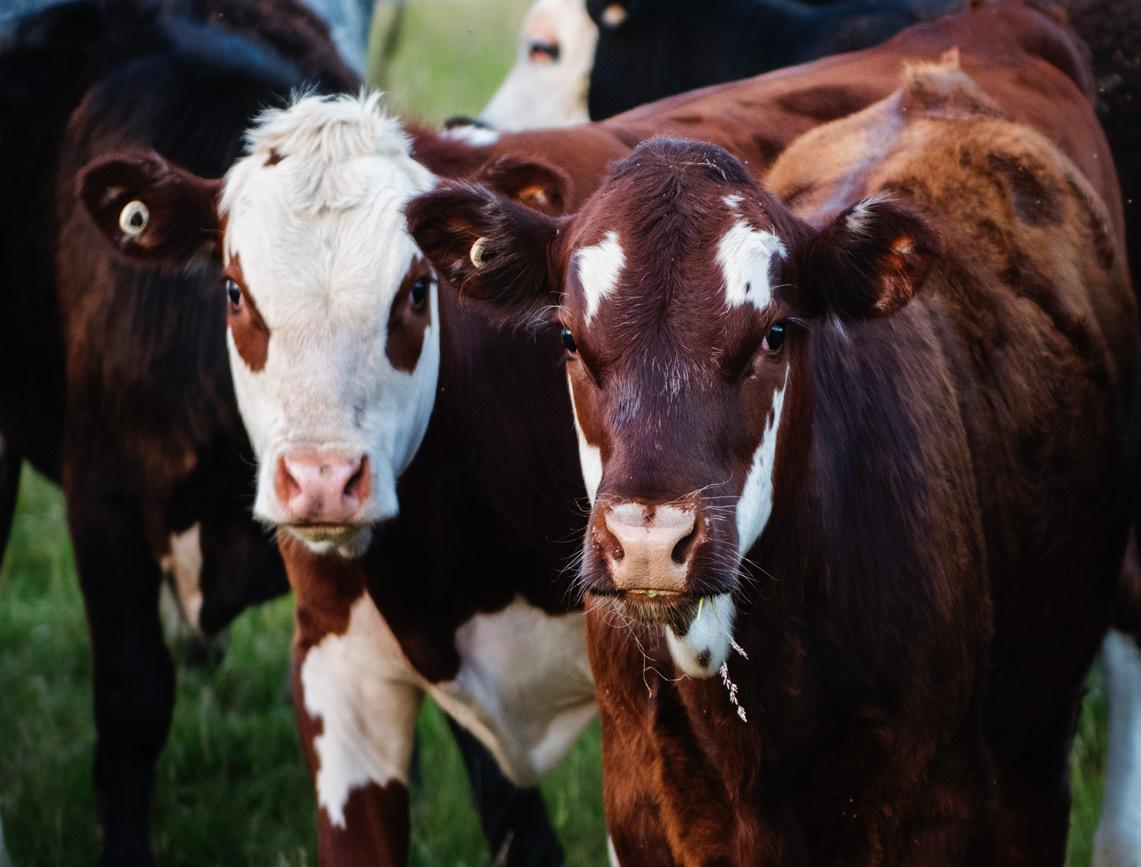







BY J’NEL WRIGHT
In 1921, Charles Mabey was Utah Governor, and Warren G Harding was in the Oval Office. The first live broadcasted baseball game featured a play-by-play of the Pittsburgh Pirates’ 8-to-5 win over the Philadelphia Phillies.
Moviegoers paid 15 cents a ticket to see Charlie Chaplin’s silent screen comedic genius and Rudolph Valentino’s smolder.
Homemakers were introduced to this new gal named Betty Crocker; French’s mustard hit the store shelves; Guccio Gucci thought he’d take a shot at selling bags, and Coco Chanel’s lucky number in the fragrance industry was five.
In the local news, on May 1, 1921, on Brigham City’s Main Street, newlyweds


in flavors. Two of the most popular menu items, the Cowboy Carson Bison Burger and the Cowgirl Kate Burger, were concocted by staff members.
Percy and Verabel Knudson opened the door of a new candy and ice cream store. From that day forward, Idle Isle Cafe secured its place in Utah’s history for over a Century.
In 1929, the Knudsons partnered with Verabel’s brother, David Call and his wife, LaRita, to expand the business. With Percy overseeing operations, David making candy, Verabel running the kitchen, and LaRita on cooking and piemaking duty, Idle Isle Cafe began offering home-cooked meals alongside homemade confections.
Idle Isle Fine Candies moved across the street in 1994. Still today, the Cafe serves satisfying daily specials like pot roast, fish, meatloaf, sandwiches, homemade soups, appetite-attacking burgers, pasta, steaks, hot turkey sandwiches, or chicken fried steak with home-mashed potatoes and
hot fresh rolls. The menu is packed with classic homemade and locally sourced dishes reminiscent of Grandma’s country kitchen. Even the lemonade is freshly squeezed.
But the menu also has room for deliciously creative options suitable for a changing palette.
Corinna Harris, who purchased the newly renovated restaurant from Travis and Jana Porter in March of 2022, is excited about the opportunity to move forward. One of her early first steps was to bring on the small plates!
Harris says appetizers are bringing more people into the restaurant. Choices like house-made onion rings, Bavarian pretzels, garlic fries, fried pickles, zucchini and mushrooms, cheese curds, and chicken wings set the stage for a modern adventure
The vision of Carson Lee, a line cook, the Cowboy Carson Bison Burger combines a generous bison pattie with pickles, fresh lettuce, tomato, cheese, a crispy onion ring, bacon, the house’s special BBQ sauce and a fried egg. Harris says it’s one of their most popular items.
The Cowgirl Kate Burger is also the brainchild of a service staff member. It offers a beef patty stacked with lettuce, tomato, pepper jack cheese, spicy ranch sauce and fried pickles.
Harris’s relationship with local growers ensures customers enjoy fresh produce and locally sourced ingredients, including a supplier delivering hydroponically grown lettuce weekly.
But let’s make room for guilty pleasures. If there was ever a time to break the routine and lead with dessert, this is

the place. The selection is the stuff dreams are made of, and a hardy slide of Idleberry pie is a famously popular choice. Described as a combination of blueberry, blackberry, and boysenberry, Idleberry will likely transform your dining experience, especially when devoured sitting in a handcrafted wooden booth–an original from when Idle Isle opened– or comfortably situated at the vintage marble counter. The light fixtures and Coca-Cola soda dispensers are also a nod to days gone by.
However, the idea of hosting a night of dining and dancing on Valentine’s Day is totally new. Harris says the community will see more communitydriven ideas like that as she drives Idle Isle Cafe into the 21st Century–with a touch of sentiment on the side.
The menu is sure to please, but for those wishing to satisfy their nostalgic taste, the apricot marmalade and the baked custard are sweet reminders of a century-old commitment to providing homestyle, quality dishes that nourished those who visited during the past 100 years and new friends who will walk through that welcoming door for many years to come.
Business Hours Monday - Thursday: 11 am to 7 pm Friday, Saturday: 11 am to 8 pm Closed: Wednesday, Sunday







BY HANNAH HASLAM, MEMBER

Anytime I get invited to a summer BBQ, I bring this potato salad and generally, I get comments about how pleasantly surprised people are at how fresh it tastes. This is a far cry from the thick, mayo-laden American-style potato salad most of us grew up with (nothing wrong with that version either though!). The dressing is lemony, light, and punchy with flavor and the variety of vegetables, fruit, and herbs give this salad a panache its American brother is missing. Take it to your next BBQ and watch as the compliments roll in!
INGREDIENTS:
2 lb. small new potatoes with peel, scrubbed well.
6, medium-sized boiled eggs, peeled and diced
1 apple, washed and diced
½ medium-sized red onion, diced small
2 tbsp. capers
½ English cucumber, diced
1 big handful of fresh dill, roughly chopped
1 bunch chives minced
1 handful parsley chopped
½ small, preserved lemon, deseeded and minced (optional)
½ cup arugula
Salt and pepper
SAUCE INGREDIENTS:
Zest and Juice of one lemon
2 generous tbsp. mayonnaise
1-2 tbsp honey
5 tbsp. olive oil
1 tsp. salt
1 small clove of garlic, finely crushed 1 tbsp whole seed
Boil the potatoes whole in well-salted water until tender. Let them cool and then dice the potatoes and add them with the rest of the salad ingredients to a big bowl. (I always wait to add the arugula until right before serving to keep it from getting soggy).
Whisk the sauce ingredients together and adjust any of the ingredients until it tastes like you want it to. Pour over the salad, note that sometimes I don’t end up needing all the sauce, but add as much as you like. Toss, taste again, and adjust seasoning if needed.
Refrigerate until ready to serve. At this point add the arugula and toss until the salad is well coated.



